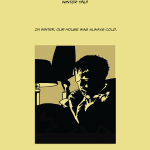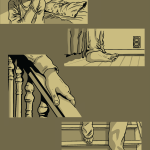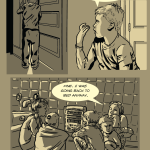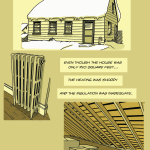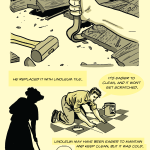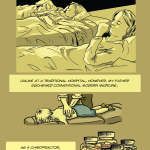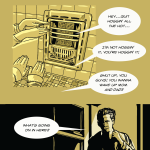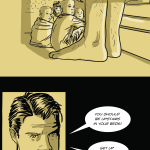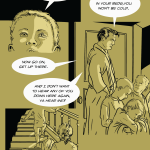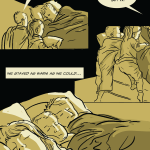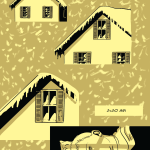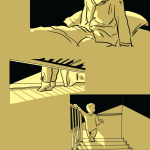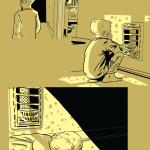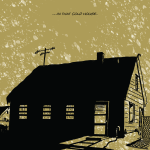I learned about ghost hunting from my mom. When I was in elementary school, she drove me down to Louisiana every summer, and we’d stomp around the boggy summer heat in old cemeteries, reviewing etched tombstones, trying to find the names and death details for her ancestors.
We slogged through swamps, heavily forested areas where the heat bugs hissed so loud, I could barely hear when she called to me. We went all over the state—Mansfield, Baton Rouge, Grand Chenier. We stayed with friends in between, drinking sweet tea and eating collard greens, cornbread slathered with slices of cold butter. I was never quite sure what my mom was looking for, or why we needed to find it out there in the heat.
My mom was bad at picking up on things. That’s why she didn’t notice at first when a spirit latched onto her one summer in Louisiana. It just slipped out of the gravestone and sunk its claws into her, like a bad smell. The thing held tight to her all the way back to rural Vermont where we lived. I didn’t notice it at first. But then, a month or two later, it made itself known when she and I were alone at her office building one night.
The office building where my mom worked was four stories—a first floor, second, an attic, and a basement. I hated the second floor. It was dark and full of offices, crowded and narrow. Whenever I stayed late with my mom, I lingered on the first floor in an open office space, next to a large row of windows.
Sometimes she worked upstairs, and that night, she was working out of her boss’s office when I went upstairs to ask her for food money. It was dark, and the lights were off in the hallway. “Mom, can I get food money?”
“For what?”
“I want to go across the street.”
She hesitated, then rustled around, appearing in the doorway at the other end of the hall. There were at least five doors between us—five different offices along the hall. Some were open, some partially, one closed. I stood at one end of them. My mom was at the other. We looked at each other for a moment, and then I got the sense that something was wrong. I remember my skin prickling, like getting goosebumps in the cold, and then one of the open doors slammed shut.
My chest tightened. I felt the fear in my chest before my brain could register what happened. A second later, I went running for my mom.
+++
Twenty years later, I move from Vermont down to St. Pete, Florida, seeking the heat of my childhood. I get a tiny studio apartment and a new job working in development at a legal aid firm.
My ex-boss from Vermont texts me once a week. I keep the selfies she sends me saved in my phone and look at them when I miss her. I’m still in love with her, even though she’s married now, and I’ve moved two thousand miles away. In her texts, she tells me I’m pretty. She asks about the grants I’m writing at my new job, the beach, my friends. You’re pretty AND smart, she says, when I send her a selfie at my office. Her paragraphs always include winky faces. She doesn’t say much about herself.
After settling into my new office at my new job in St. Pete, I decide to decorate my desk. It’s black and chic and empty, so I print out pictures of me with my four best friends and tape them up on one of the monitors. There’s an empty space at the bottom. I leave it for a day, then print one of the selfies Lauren sent me and tape it up.
Back when I worked with her, Lauren and I spent eight to ten hours a day together. We went on field trips—to Stowe, to the islands, to happy hours. She told me once, on a longer trip, that things weren’t so easy for her as a child.
“But you’re so good with your dad,” I said. “You guys are like best friends.”
“It wasn’t always like that.”
“What was it like, then?”
Her mouth tightened. She was always doing weird things with her mouth – pursing her lips, parting her lips when she concentrated, these uncomfortable, awkward things that I loved watching. Sometimes, I felt her face moved on its own, like something else was guiding her that she couldn’t see or understand. “One time my brother and I were fighting, and Dad came up and,” she gestured with her hands, “wham. Knocked our heads together.”
“What was it like with your brother?”
“We hated each other,” she said. I asked why. She told me he could never forgive her for something. I waited for her to tell me what. She never did.
After two or three days of having her picture up at the office, I take it off the computer monitor and tuck it away inside my desk. I don’t look at it often, but sometimes, when I get out tea to brew, her face will come into view—the blonde hair, the freckles. Every time I see it, I think about those months I spent listening to her plan her wedding, talking about bridesmaids and dinner menus. I think about all the times I cried in the bathroom. How her face tightened when I told her I liked her. How inferior I felt standing next to her fiancé. How she looked at him like I wasn’t even there at all.
Yet every time I get close to throwing her picture away, she’ll text again.
I miss you, pretty, she’ll say and send a new selfie. I hope you’re enjoying your new life.
+++
The ghost that followed my mom home wasn’t malevolent, but it liked attention. It tapped on the walls at her work when she stayed late with me, large knocks on the plaster, as if someone were stuck in there from the other side. It ran up and down corridors and through the hallways. It smelled like cigarette smoke. The scent would balloon out, linger, then move. I’d sit there alone at night and all of a sudden the scent would creep up, eerie as a cold night wind, slipping its arms around me.
The next year, I started staying home alone at night instead of going to work with Mom, and the sounds disappeared. The spirit went away.
“You didn’t hear from her?” I’d ask my mom, day after day.
“Nothing,” she said. “Must’ve gone home with somebody else.”
I thought about the ghost off and on, wondering where it went, but as I grew, my interests diverged outward, and I thought about it less and less. Other things began taking up my time—basketball, grades, friendships.
In the seventh grade, I fell in love for the first time. Gina was short with long hair and a crooked smile. She was also my biology teacher. I hung around with her after school every day, and she paid special attention to me. I thought it was because she loved me.
It wasn’t until later that I found out she had a sexual relationship with a boy only a year older than me. She was fired immediately and, in the following months, lied to me repeatedly, begging me to help her get her job back, telling me she loved me. She missed me, she said. She asked about school, about sports, like nothing bad had ever happened.
After months and months, I stopped emailing her back. It hurt to be in contact with her. I felt creepy and weird, and thought there was something wrong with me for loving someone who’d done something so bad.
Still, even after cutting off contact, I thought about her. My thoughts eventually became less about missing her, and more about trying to understand what she had done. Why had she done it? Why did she lie to me? Why did she pretend she cared?
That’s the part that haunted me. I thought she loved me like I loved her. But she never really did.
+++
After I finally stop talking to Lauren, I go on my first date in over a year. I walk downtown in a button-up shirt and skinny jeans, sweat pinching under my arms as a cool breeze snakes in through my shirt sleeves. I’m early, so I grab a beer across the street at a local gay bar and watch the crowd around the coffee shop across the street where I’m supposed to meet my date.
We’ve been talking for a few weeks now, and I really like her. She’s in her early forties, and a therapist. She communicates well and gives me space when I need it. I like her boundaries and her maturity. I like how she looks and what she does for a job and how giving she can be.
I spot her walking in and finish up my beer, then head over. She recognizes me immediately and opens her arms for a hug. We sit at a porcelain bar, and she orders a fancy coffee while I get a beer. We make small talk at first, then ease into a conversation. I try to keep my mind on the present and not the worries burbling in my stomach. Everything seems to go well. After two hours, she heads off to a dinner with her friends. I visit a friend, too, at a bar down the street, and we talk until it’s pitch black outside and the wind gets too cold for sitting outside anymore.
It’s on the walk back that I start to panic.
This woman is beautiful, successful, and healthy. What could she possibly want from me? I worry about what I said during our date, how I acted. I worry I’m going to end up liking her too much and then she is never going to like me back the same way.
After crawling into bed, I start to cry. The wind is strong and cold in a way I never expected Florida to be. I stay huddled in the blankets, my face pressed to the pillow.
I didn’t stop dating just because Lauren broke my heart. I stopped dating because it’s just too hard. I can’t like someone without immediately wondering how they will hurt me, like Lauren hurt me, and Gina. It’s been fifteen years now since she was fired, but she still pops up sometimes, slipping out somewhere from the shadows, this little voice telling me that she is going to leave. She is going to hurt you, like all the women you love. I don’t know how to shut it off or make it go away.
+++
After leaving Vermont, I spent five weeks on an “art farm” in rural Nebraska to work on my writing. There, I learned how to install drywall, build survival fires, and cohabitate with field mice. The house I lived in was more than a hundred years old and had been transplanted to Nebraska without its foundation, then built back up into something that could stand alone.
The bones of the house had potential. They were wood, weathered and old, but with moments of stark beauty. The house was slightly crooked, too, and with the additions that had been made on the western wall, it looked like it had a face—two eyes, a nose, and a zippered mouth.
When I first arrived, I was terribly uncomfortable in the house. There were too many people there, too much going on. But after it started getting cold, and everybody left, I transferred bedrooms and began liking the space much better.
I started noticing the phantom noises during the afternoons. I’d sit downstairs in the kitchen drinking tea and writing, and I’d hear footsteps above me. My roommates had work studios elsewhere, and I was alone. I’d call out. Listen to the silence. Then it would start up again. It went away when my roommates were there, but on several occasions when I was nestled in bed, I got the distinct feeling there was something else in the room with me, standing at the edge of my bed.
One night, I had a dream that I was a little boy away at a boarding school in Greece. I saw everything from his perspective—the cliffs above the sea, white foam crashing, the old school uniforms, the sunlight. I’d never had a dream from someone else’s perspective before. I told my roommates about it the next morning.
“Could’ve been a past life dream,” one of them said.
We all sat downstairs, sipping tea and coffee as the sun burned in through the windows. The smell of buttered toast hung in the air. “Or it could’ve been a memory from someone who died in here,” the other said.
I went about the remainder of my time in Nebraska believing there was a lonely child ghost in that house, just looking for a friend. I played music in the afternoons to cover up his stomping. Before I went to bed, I said goodnight to him. I told him to rest while we were all asleep.
Nebraska was where I stopped fearing ghosts. Nebraska was also where I unfriended Lauren on Facebook because I couldn’t stand to see any more of her wedding pictures. It was where I cried in my sleep, and dreamed about her, and tortured myself wondering what I had done wrong, what I could’ve done better to make her love me.
Most days, I woke up scared she would text me something about her new life with her new husband and I’d have to pretend, like I’d already done for a year, that everything was fine, and it didn’t tear me to shreds. Most nights, I went to bed afraid I would keep Lauren inside of me forever.
+++
A week after my date in St. Pete, I dream I’m living in a haunted house. It’s a large mansion with thinly made plywood on the outside, but with grandiose, Victorian-style decor on the inside. I go from room to room in the house with a feeling of dread at the back of my neck. I know something’s behind me, but I don’t want to turn around to look. The entire mansion is riddled with shadows, and I keep throwing open the curtains only to have them fall shut again when I move away.
Finally, I realize I have to go. I can’t stand it anymore. I pack up my car with all my things. I place some stuff on top of the car, twining rope around the door handles to keep everything in place. I hurry. I can feel the thing behind me, to the side of me, all around me.
After getting in the car and starting to drive away, my tension begins to ease. I look around at the trees. The pines hang low, their needles brushing the windshield as I drive.
Suddenly, the car engine sputters. I know then that the ghost is still with me, even though I’ve driven away. It’s hanging onto the car, trying to keep me from getting away. I fight with the stick shift, but the car slows. I’m driving downhill and hope the momentum will keep me going, but then I lose control of the steering. The car fishtails. I take a turn into some bushes and then for a second, it’s all green and moss and branches scraping at glass. At the end of the underbrush, my view clears. I’m at the edge of a cliff. Rocks kick up under the car. Panic grips my chest, but there’s nothing I can do. It’s too late.
I open my mouth to cry out and then I’m airborne, soaring over a hundred-foot fall, a rush of rapids waiting to devour me below.
+++
I wake up in the morning with that familiar feeling—that something else is in the room with me. It’s never happened in the St. Pete studio before, and the sensation is slightly different than it was in Nebraska. This morning, it’s more like this thing was with me and, as I woke, it slipped away.
I rise and make the bed. Shower. I bustle around in the tiny space, heating tea and stir-frying potatoes and eggs with onion and pepper. It’s cool out, and the sun peeks in through the blinds, falling in strips across the kitchen tile. I don’t have the sense of anything lingering anymore. It all faded as the sleep washed away from me.
My childhood was all about finding ghosts, about hunting them, and understanding them. I never learned how to get rid of them, though. It seemed like they were always just there, until they decided to go away, or I left wherever they were haunting. I want it to be like that with Lauren and Gina. I want to just wake up one day and they’ll both be gone from me.
That morning, I think a lot about my time in Nebraska. I think about how calm I was in that house, even knowing something else was there with me. I remember the cold mornings and the afternoons when the sun shined in, warming my cold feet. I remember turning the light off at night and looking at the outline of the room, my vision blurred without my glasses, dipping over rounded spots and shadows. “Good night,” I’d say to the room. “Rest now, so we can all get some sleep.”




.jpg)




















